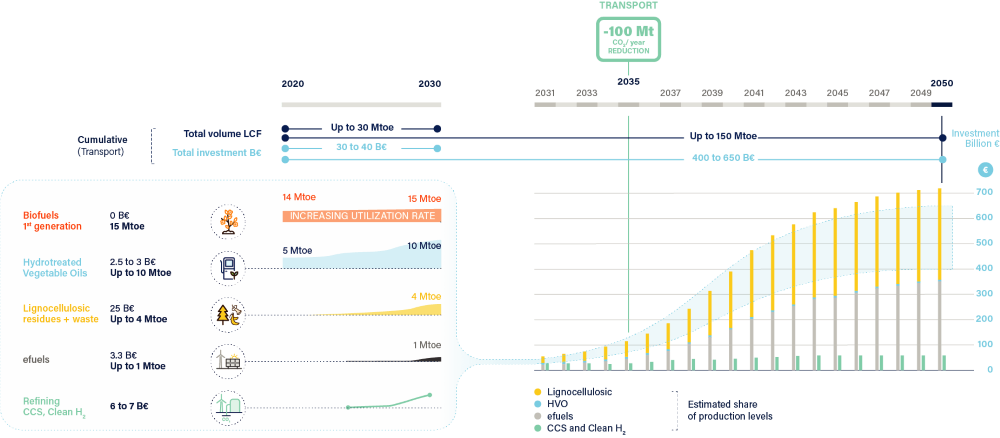.png)
Clean Fuels for All
A pathway to climate neutrality
The ambition of the European Union is to be climate neutral by 2050. The European Fuels Manufacturers Industry supports the same ambition.
We demonstrate how low-carbon liquid fuels can decarbonise transport, enabling all new and old road transport vehicles to be climate neutral by 2050, and securing the availability of these fuels for the aviation and maritime sectors.
Our industry is transforming, and we have developed a comprehensive potential pathway of how we, together with our partners, can contribute to meeting the 2050 climate neutrality challenge. This work is the continuation of our Vision 2050, which outlined back in 2018 “A Pathway for the Evolution of the Refining Industry and Liquid Fuels”.
By 2050, at the latest, every litre of liquid fuel for transport could be net climate neutral, enabling so the decarbonisation of aviation, maritime and road transport.
This pathway will require an estimated €30 to €40 billion investment between 2020 and 2030, including the creation of advanced biofuel and e-fuel plants, increasing the production of low-carbon liquid fuels up to 30 Mtoe/y in 2030. Major investments could start in the next years, with first-of-a-kind biomass-to-liquid and e-fuel plants coming into operation at an industrial scale no later than 2025.
By 2050, the total investment needed is estimated between €400 and €650 billion, enabling the availability of 150 Mtoe of low-carbon liquid fuels.
Add Carbon Capture Storage (CCS) for the capture of emissions in low carbon fuels production, and, in combination with electrification and hydrogen technologies, the transport sector could reach near climate neutrality.
This pathway is ambitious. The good news is our transformation has already begun. Our success will however depend on broad multi-stakeholder partnerships and investor confidence, as well as on political vision. We need everyone on board.
With low-carbon liquid fuels, EU Fuel Manufacturers are ready to contribute to climate-neutral transport.
Scientific and technology background
This pathway was developed by Concawe, the fuel manufacturing industry’s scientific and technical body, as part of a series of studies under the Low Carbon Pathways programme. This programme aims at exploring the potential, both in quantitative terms and over a reference timeline, of the production of low-carbon liquid fuels until 2050, their effective contribution to the decarbonisation of transport and the scale and cost of the required industry transformation.
The assessment carried out by Concawe is using the European Commission’s Communication ‘A Clean Planet for All’, and more specifically the 1.5°C TECH scenario, as a reference for 2050. Aligned with the EU’s Paris Agreement commitments, this ambitious scenario achieves climate neutrality in 2050.
The assessment also:
- Investigates opportunities to achieve significant reductions in the carbon intensity of future low-carbon fuels, compared to a 100% fossil fuel reference, from the production to the end-use stage following a Well-to-Wheel (WTW) approach.
- Evaluates the potential deployment of the most promising technologies starting today and towards 2050, with a focus on sustainable food-crop-based biofuels, biomass & waste-to-liquid (BTL), hydrogenation of vegetable oils/waste & residues, and e-fuel technologies, with a view to replace fossil CO2 by either biogenic (potentially including Direct Air Capture) or recycled CO2 from industrial sites.
- Includes other key mitigation technologies (key enablers) such as Carbon Capture and Storage (CCS) and Clean Hydrogen applied in refineries to reduce the carbon intensity of produced fuels as from today, and with clear synergies with alternative feedstocks.
- Considers investment levels as best estimate of the order of magnitude of technologies still in development.
As a result of the above methodology and based on the European Commission’s plans, as well as on the accelerated development and scaling-up of the low-carbon fuel technologies identified, we estimated the amount of liquid fuels required and potentially available by 2035 and beyond.



